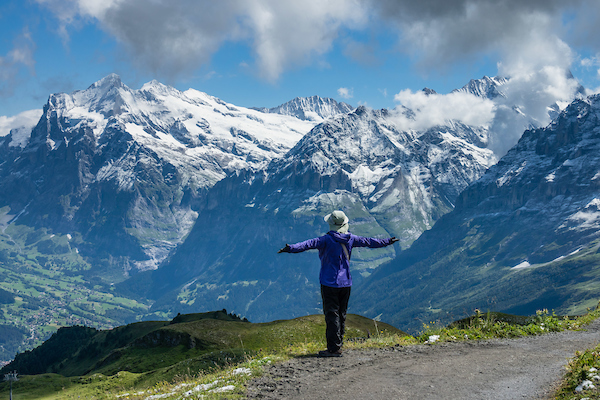Everything seems magical when you arrive in Switzerland — until you start to feel a touch of altitude sickness. Then the fresh mountain air feels thinner by the second, and your vacation instantly becomes less enjoyable.
Luckily, the most common form of altitude sickness isn’t dangerous, just uncomfortable. Your symptoms may include dizziness, nausea, and headache, but most people don’t require professional medical help.
Here’s what you should expect and how you can overcome your altitude sickness. After all, the grandeur of the Alps awaits!

What is altitude sickness?
Altitude sickness hits when people suddenly experience an elevation change. Since air pressure is lower at high altitudes, the human body has to learn how to function with thinner oxygen.
You can’t go very far in Switzerland without bumping into mountains, so high altitude is just part of life for the Swiss. Their small country is home to 48 peaks that reach at least 4,000 meters, and the average elevation is 4,429 feet (1,350 meters). Unless you’re visiting the Alps directly after a trip to the Himalayas, plan to experience a little bit of altitude sickness.
There are three types of altitude sickness, but you won’t need to worry about the severe ones (High Altitude Pulmonary Edema and High Altitude Cerebral Edema). You’ll just have to deal with Acute Mountain Sickness — the only type of altitude sickness we’ll refer to in this post.
Most people come down with altitude sickness 12 to 24 hours after arriving at a higher elevation. The symptoms include dizziness, nausea, headache, muscle aches, vomiting, fatigue, shortness of breath, sleep problems, and decreased appetite. If you develop a headache and at least one other symptom on this list, you probably have altitude sickness.
Anyone can experience altitude sickness, regardless of age, level of physical activity, or overall health.

What’s the best way to treat altitude sickness?
Going to a lower elevation is the most effective way to treat altitude sickness. If your case is mild, your symptoms should ease up fairly quickly, and over-the-counter medications will improve your headache. However, if you show several symptoms, and if going to a lower elevation doesn’t help, you should seek medical attention.
Of course, there are several things you can do to prevent altitude sickness before you even experience it. First of all, if you fly into Switzerland, you’ll land at a relatively low elevation (1,411 feet at the Geneva Airport, and 1,417 feet at the Zurich Airport). If possible, stay below 10,000 feet (3,048 meters) for a full day while you acclimate.
When you begin climbing, hiking, or walking above 10,000 feet, gain no more than 1,000 feet per day. If you do ascend more than 1,000 feet, remember the old adage to “climb high, sleep low” — meaning you should spend the night at a lower elevation. Also, plan a rest day for every 3,000 feet you gain in elevation.
It’s important to stay hydrated. Drink a gallon of water every day, and make sure that about 70 percent of your calories come from carbs. Avoid tobacco and alcohol for two days before your arrival in Switzerland.
(If you’re looking for more information on safe trekking, check out this article written by one of our Alpenwild guides.)
With a little self-care, you should be in great shape to drink in the beauty of the Alps. Photos don’t do justice to Switzerland’s majestic peaks, and it won’t take long before you start to relish the fresh mountain air. Your experience will be unforgettable!
Alpenwild guides are certified professionals, and our tours are designed to push our clients without breaking them. Even on our most challenging treks, like the Tour du Mont Blanc and the Haute Route, you can rest easy and know that you’re in good hands!
- It’s almost Swiss National Day! - July 26, 2018
- Celebrating Christmas in Switzerland - June 25, 2018
- The Tour du Mont Blanc: one of the world’s greatest adventures - June 7, 2018







